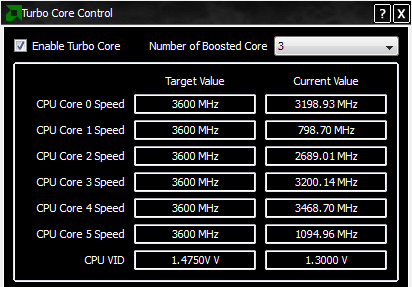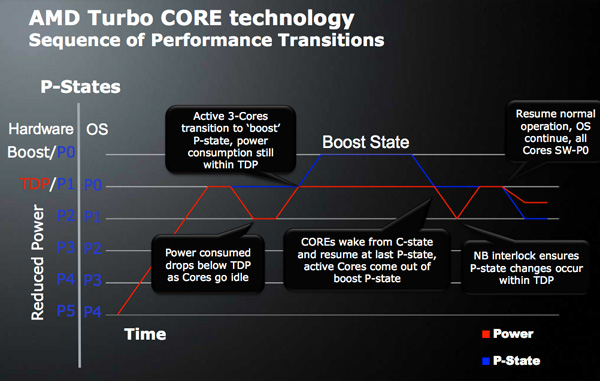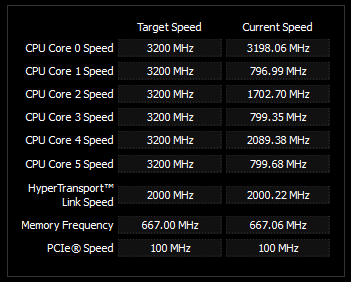AMD's Six-Core Phenom II X6 1090T & 1055T Reviewed
by Anand Lal Shimpi on April 27, 2010 12:26 AM EST- Posted in
- CPUs
- AMD
- Phenom II X6
AMD’s Turbo: It Works
In the Pentium 4 days Intel quickly discovered that there was a ceiling in terms of how much heat you could realistically dissipate in a standard desktop PC without resorting to more exotic cooling methods. Prior to the Pentium 4, desktop PCs saw generally rising TDPs for both CPUs and GPUs with little regard to maximum power consumption. It wasn’t until we started hitting physical limits of power consumption and heat dissipation that Intel (and AMD) imposed some limits.
High end desktop CPUs now spend their days bumping up against 125 - 140W limits. While mainstream CPUs are down at 65W. Mobile CPUs are generally below 35W. These TDP limits become a problem as you scale up clock speed or core count.
In homogenous multicore CPUs you’ve got a number of identical processor cores that together have to share the maximum TDP of the processor. If a single hypothetical 4GHz processor core hits 125W, then fitting two of them into the same TDP you have to run the cores at a lower clock speed. Say 3.6GHz. Want a quad-core version? Drop the clock speed again. Six cores? Now you’re probably down to 3.2GHz.
| Single Core | Dual Core | Quad Core | Hex Core |
 |
 |
 |
 |
 |
 |
 |
 |
This is fine if all of your applications are multithreaded and can use all available cores, but life is rarely so perfect. Instead you’ve got a mix of applications and workloads that’ll use anywhere from one to six cores. Browsing the web may only task one or two cores, gaming might use two or four and encoding a video can use all six. If you opt for a six core processor you get great encoding performance, but worse gaming and web browsing performance. Go for a dual core chip and you’ll run the simple things quickly, but suffer in encoding and gaming performance. There’s no winning.
With Nehalem, Intel introduced power gate transistors. Stick one of these in front of a supply voltage line to a core, turn it off and the entire core shuts off. In the past AMD and Intel only put gates in front of the clock signal going to a core (or blocks of a core), this would make sure the core remained inactive but it could still leak power - a problem that got worse with smaller transistor geometries. These power gate transistors however addressed both active and leakage power, an idle core could be almost completely shut off.
If you can take a single core out of the TDP equation, then with some extra logic (around 1M transistors on Nehalem) you can increase the frequency of the remaining cores until you run into TDP or other physical limitations. This is how Intel’s Turbo Boost technology works. Depending on how many cores are active and the amount of power they’re consuming a CPU with Intel’s Turbo Boost can run at up to some predefined frequency above its stock speed.

With Thuban, AMD introduces its own alternative called Turbo Core. The original Phenom processor had the ability to adjust the clock speed of each individual core. AMD disabled this functionality with the Phenom II to avoid some performance problems we ran into, but it’s back with Thuban.
If half (or more) of the CPU cores on a Thuban die are idle, Turbo Core does the following:
1) Decreases the clock speed of the idle cores down to as low as 800MHz.
2) Increases the voltage of all of the cores.
3) Increases the clock speed of the active cores up to 500MHz above their default clock speed.

The end result is the same as Intel’s Turbo Boost from a performance standpoint. Lightly threaded apps see a performance increase. Even heavily threaded workloads might have periods of time that are bound by the performance of a single thread - they benefit from AMD’s Turbo Core as well. In practice, Turbo Core appears to work. While I rarely saw the Phenom II X6 1090T hit 3.6GHz, I would see the occasional jump to 3.4GHz. As you can tell from the screenshot above, there's very little consistency between the cores and their operating frequencies - they all run as fast or as slow as they possibly can it seems.
| AMD's Turbo Core Benefit | |||||
| AMD Phenom II X6 1090T | Turbo Core Disabled | Turbo Core Enabled | Performance Increase | ||
| x264-HD 3.03 1st Pass | 71.4 fps | 74.5 fps | 4.3% | ||
| x264-HD 3.03 2nd Pass | 29.4 fps | 30.3 fps | 3.1% | ||
| Left 4 Dead | 117.3 fps | 127.2 fps | 8.4% | ||
| 7-zip Compression Test | 3069 KB/s | 3197 KB/s | 4.2% | ||
Turbo Core generally increased performance between 2 and 10% in our standard suite of tests. Given that the max clock speed increase on a Phenom II X6 1090T is 12.5%, that’s not a bad range of performance improvement. Intel’s CPUs stand to gain a bit more (and use less power) from turbo thanks to the fact that Lynnfield, Clarkdale, et al. will physically shut off idle cores rather than just underclock them.

I have noticed a few situations where performance in a benchmark was unexpectedly low with Turbo Core enabled. This could be an artifact of independent core clocking similar to what we saw in the Phenom days, however I saw no consistent issues in my time with the chip thus far.










168 Comments
View All Comments
Belard - Tuesday, April 27, 2010 - link
While in general the upper end i5/i7 CPUs are a bit faster, there are other costs involved.Basic AMD boards are $80, upper end Cross-fire boards are $100~150, while typical P55 boards are $100~200, and X58s are $200~300.
So, with cost of the intels is about $150~400 in price to get a few seconds performance improvements.
Also, if someone buys a lower-end i3 CPU, they can't upgrade to a top end i7 CPUs because of different CPU sockets. While those who bought an AMD class board a year ago will most likely have the option to upgrade.
Scali - Thursday, April 29, 2010 - link
Who would want to run a six-core CPU on a two-year old board though?You wouldn't have things like USB 3.0, SATA 6 gbps, probably not even PCI-express 2.0 either.
I don't think it's a good idea to upgrade a CPU in the same board in general.
Usually the old board will severely hamper performance, so you're not getting your money's worth for the new CPU. And you'll miss out on the new features.
In all the years that I've been building PCs for myself and for friends/family, I have never found a CPU-upgrade very compelling, and I wouldn't recommend it to anyone.
I wouldn't be surprised if it's better to get a 1055T instead of a 1090T, and spend the extra money on a new board, rather than running the 1090T on the old board. There's a very interesting article in there for Anand I suppose.
stalker27 - Tuesday, April 27, 2010 - link
Tested on Crosshair IV, th 1090T did far better than any i7... proves how much MSI and Gigabyte suck at this thing.hooga - Tuesday, April 27, 2010 - link
Can you please make a note of wheather or not all power saving functions like C"n" Q and C1 for PhenomII is activated?Anand Lal Shimpi - Tuesday, April 27, 2010 - link
All power saving features were enabled on all chips - C1E and CnQ were enabled on the X6. You need to enable these features otherwise Turbo Core doesn't work.Take care,
Anand
KaarlisK - Tuesday, April 27, 2010 - link
With 6 cores, memory bandwidth might be more important. The gain from DDR3 for Phenom II was minimal. Or is L3 cache bandwidth the bottleneck?hooga - Tuesday, April 27, 2010 - link
I meant C1E obviously, and what about overcloking? Just a half heartet attempt? makes me wonder if there is some fanb** no, im not going to say that word, iv always seen you guys as very professional and cant quite believe that, im hopeing that you post the 4,2GHz results very soon. :)silverblue - Tuesday, April 27, 2010 - link
Bit-tech couldn't exceed 3.89GHz with their sample. Guru3d managed 4.1GHz using an OCZ Vendetta air cooler.These things are usually quite variable.
silverblue - Tuesday, April 27, 2010 - link
That's certainly helpful.Considering the intended uses for this type of processor - i.e. heavily threaded applications - it offers more performance for the price as compared to anything Intel is throwing out.
Yes, Intel's products are faster per clock, but they just can't match AMD for performance at a given price point. Guru3D touched upon the point that you could build a 1055T machine for $600; that's $400 less than the 980 on its own. How much would it cost to build a 980 setup, or even a 930 solution in comparison?
fitten - Tuesday, April 27, 2010 - link
Depends on where you buy stuff... Microcenter runs great deals on the i7/930 (around $200), for example.